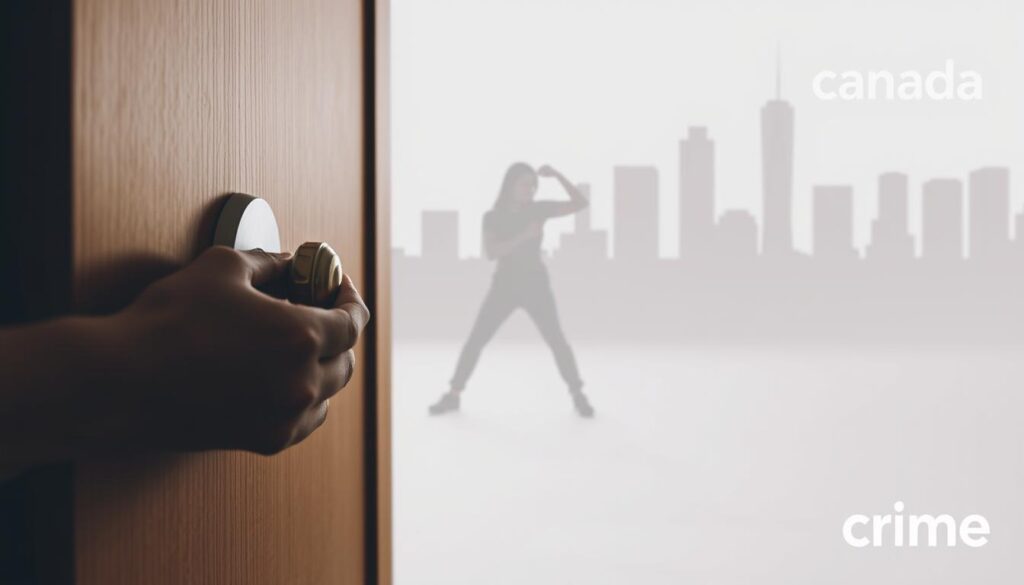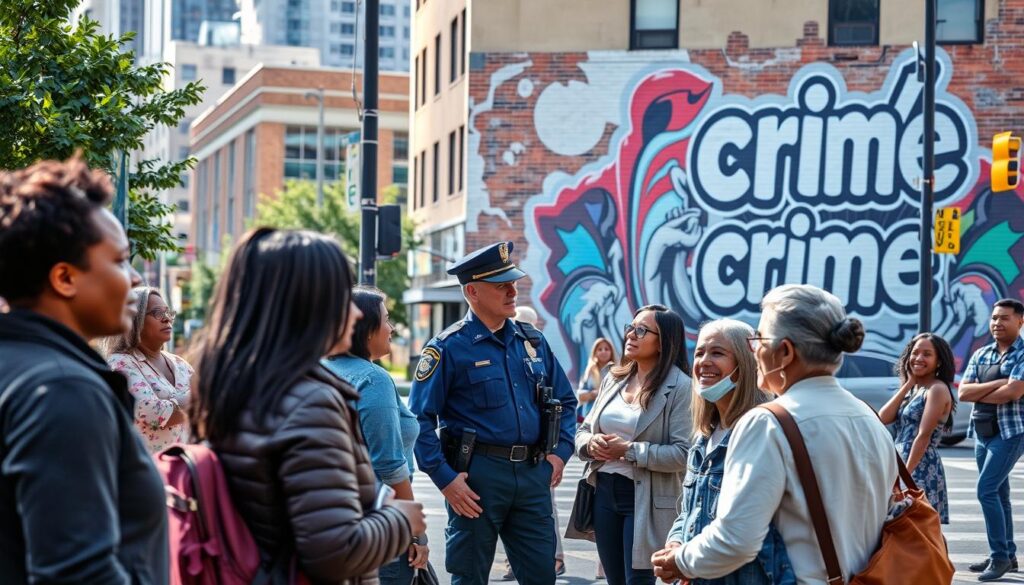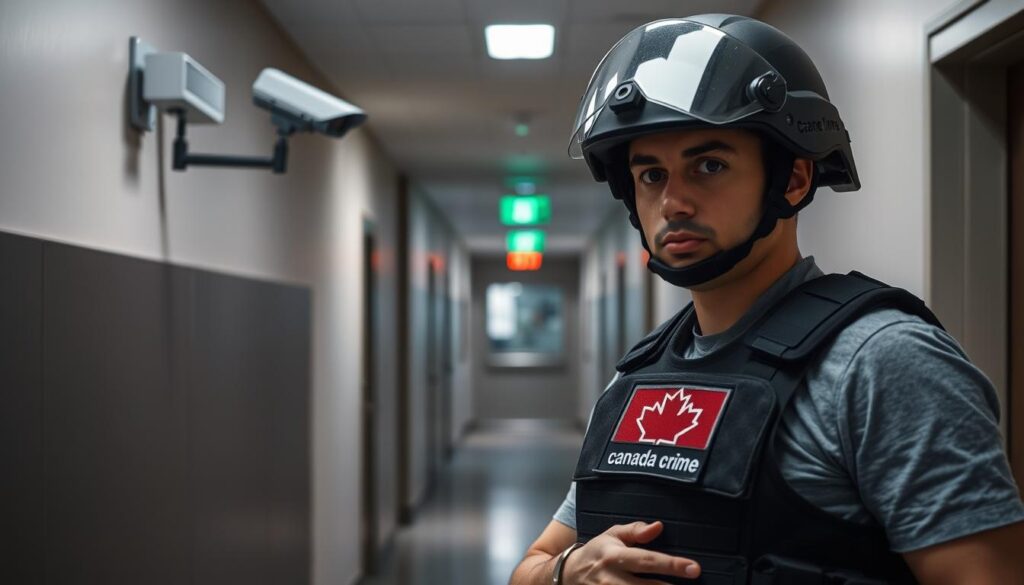Did you know that over 50,000 incidents of aggravated assault were reported in Canada in a year? This huge number shows why it’s so important to learn and use violence prevention tips. By reading this article, you will find useful advice on how to avoid aggravated assaults. This will help keep you and your community safe.
Aggravated assault impacts victims, their families, and whole communities deeply. Learning about self-defense tactics and spotting early warning signs can lower the chances of such violence. This knowledge is a big step towards safety.
This guide aims to share effective ways to improve your safety. It covers how to stay safe personally, notice risky behaviors, and understand laws about aggravated assault. By the end of this read, you’ll know how to protect yourself and contribute to a safer place for everyone.
Understanding Aggravated Assault
Aggravated assault is a serious crime that can hurt someone badly. It’s critical to know what it means and how it affects people and places. This knowledge helps us make better plans to keep communities safe.
Definition and Legal Context
In Canada, aggravated assault means hurting someone on purpose, often with a weapon. While laws differ a bit in every province, they all agree on one thing: the injury is severe. Many times, it can be life-threatening.
Statistics in Canada
The group, Statistics Canada, tracks crime data. They show how aggravated assault happens. Recently, the number of these assaults has changed a lot in different areas. Yet, it’s a big issue everywhere in Canada.
| Year | Cases Reported | Rate per 100,000 Population |
|---|---|---|
| 2018 | 14,568 | 39.6 |
| 2019 | 15,123 | 41.2 |
| 2020 | 13,980 | 38.0 |
| 2021 | 14,250 | 39.2 |
This info shows why we need good ideas to stop aggravated assault. And keep everyone safe.
Impact on Victims and Communities
Aggravated assault hurts victims in more ways than one. They might face long-term mental health issues like PTSD. It doesn’t stop there; neighborhoods also pay a big price. This includes higher healthcare costs and less happiness around.
By taking strong steps, we can lessen these negative impacts. Doing so helps everyone feel better and safer.
Recognizing Early Warning Signs
Knowing the early signs is key in stopping aggravated assault before it starts. You can spot these *behavioral indicators of assault* to stay safe from harm.
Behavioral Indicators
Some important signs may show someone could be a threat. Look for aggressive body language, sudden anger, and controlling actions. Spotting these signs early can be a big step in keeping yourself safe.
Situational Awareness Tips
Being aware of what’s happening around you helps prevent attacks. Pay attention to your surroundings. If something feels off, trust that feeling.
Watching for *behavioral indicators of assault* while knowing how to stay safe helps you. This knowledge can make places safer for everyone.
Tips to Prevent Aggravated Assault
It’s very important to take steps to ensure your safety to prevent aggravated assault. Being mindful of your environment and using effective safety methods can really help.
Always be alert and listen to your gut feeling. If something doesn’t seem right, it’s best to avoid it. Stay away from dark, quiet areas at night. Try to have a friend with you or use trusted rideshare services instead of walking solo.
It’s a good idea to have a personal safety tool like pepper spray or a whistle with you. These can make you feel safer and might keep attackers away. Taking self-defense classes can also make you feel stronger and teach you how to defend yourself.
“Staying vigilant and prepared are key aspects of personal safety. Simple actions like being aware of your environment and avoiding risky areas can help prevent situations from escalating.”
Today, technology gives us new ways to keep safe. Personal safety apps that let your friends know where you are can be really useful. GPS trackers are also great, especially if you’re often in new places or travel a lot.

Being extra careful when meeting new people or online is also key. Always check if someone you’re letting into your home is who they say they are. Be careful with your personal info and think twice before sharing where you are on social media.
Using these safety tips and being cautious can lower your risk of aggravated assault. It helps you and those around you stay safe.
Here are the main tips for preventing aggravated assault:
| Prevention Tip | Action |
|---|---|
| Stay Alert | Avoid distractions and be aware of your surroundings. |
| Travel Safely | Use well-lit, populated routes; avoid traveling alone. |
| Carry Safety Devices | Pepper spray, whistles, or alarms can deter attackers. |
| Learn Self-Defense | Attend classes to gain self-defense skills. |
| Use Safety Apps | Share your location with trusted contacts using apps. |
| Verify Credentials | Ensure service providers and sellers are legitimate. |
| Keep Information Private | Do not share your location or personal details online. |
Self-Defense Tactics and Training
Learning how to defend yourself improves your safety. The right training boosts your confidence and readiness for tough situations.
Martial arts is a top way to shield yourself from attacks. Training in Brazilian Jiu-Jitsu, Muay Thai, or Krav Maga gives you real-world skills. Since each one teaches different moves, pick what suits you best.

Classes on staying aware and calming tensions are also key. They help you spot dangers early and keep cool under stress. Adding these tips to your daily life improves how you handle threats.
- Boxing and striking techniques – develop offensive and defensive strategies.
- Grappling – learn how to counteract physical attacks and immobilize your assailant.
- Awareness and avoidance – recognize and steer clear of potentially hazardous situations.
Actually practicing self-defense is vital. Joining a local program gives you skills, community, and support. The National Self-Defense Institute (NSDI) in Canada has certified courses for all ages and levels.
Structured self-defense training is super important for your safety. Keep practicing and stay up to date on training to always be ready.
Community Safety Practices
Helping communities to stay safe is key. Neighborhood Watch programs and bringing people together help stop serious crimes. Working together and being alert lets everyone live in a safer place.
Neighborhood Watch Programs
Neighborhood Watch programs help keep our communities safe. They bring neighbors together to watch out for any strange activities and tell the police. This teamwork not only stops criminals but also makes the neighborhood bond stronger. With everyone working together, there is less crime.

Community Engagement Initiatives
There’s more to safety than just Neighborhood Watch. Engaging the community is also key. Having regular meetings, workshops on safety, and local events helps everyone stay aware and involved. Plus, talking openly with local authorities makes our safety efforts even better.
| Initiative | Key Benefits | Community Role |
|---|---|---|
| Neighborhood Watch | Reduces crime, builds trust | Monitor and report suspicious activities |
| Community Meetings | Promotes awareness and unity | Attend and share information |
| Safety Workshops | Educates residents on safety practices | Learn and apply safety tips |
| Local Events | Encourages community bonding | Organize or participate in events |
De-escalation Techniques
De-escalation techniques are key in keeping violent situations under control. They help you safely navigate interactions that could turn violent. By using the right words and body language, you can calm aggressive behaviors.
Staying calm and showing it is vital for de-escalation. Your body language is really powerful. By keeping your hands in view and avoiding quick moves, you make a big difference.
Speaking in a soft, calm way is just as important. It can ease tension. Really listening and understanding someone’s feelings is crucial. Saying things like “I understand why you might feel this way” can acknowledge their emotions well.
It’s also advised to keep a safe space between you and the upset person. This ensures you have a way to leave if needed. Not making direct eye contact, while still watching them, can keep things from getting worse.
| Technique | Description |
|---|---|
| Calm Demeanor | Maintain a relaxed body posture and avoid aggressive gestures. |
| Soft Voice | Speak in a calm and soothing tone to reduce tension. |
| Empathetic Listening | Acknowledge the person’s feelings without necessarily agreeing. |
| Safe Distance | Create a physical space to ensure both safety and an exit route. |
| Non-Threatening Stance | Keep your hands visible and avoid direct eye contact. |
Practice these de-escalation techniques often so they become a habit. The main aim is to lower tension and stop any violence, keeping everyone safe.

Protective Measures for Personal Safety
To keep yourself safe, it’s important to follow protective measures and stay alert. Whether at home or out, certain tactics can greatly increase your safety.
Home Safety Tips
Your home should feel secure. To ensure this, it’s important to take strong safety steps. Begin by getting a good security system that includes cameras and alarms. Make sure all doors and windows have solid locks. Also, adding motion-sensor lights around your house helps.
Remember to check these locks every night and before you leave your house. Teaching your family about these safety steps is also key.
Public Place Safety Strategies
Being careful in public places is also crucial. Stay alert and keep off your phone to avoid distractions. Always choose to be in areas that are well-lit and have people around. Listen to your gut—if something doesn’t feel right, it probably isn’t.
Changing up your travel routes can also make you less of a target. And know where safe places are, in case you need help quickly.

Importance of Reporting Suspicious Activities
It’s very important to report suspicious activities to keep our community safe. By telling the authorities about strange behavior or incidents, you help stop crimes before they happen. This action helps decrease crime and makes your neighborhood safer.

How to Report
To make sure your report on suspicious activities counts, follow these steps:
- Contact local law enforcement: For non-urgent things, use the non-emergency number. Call 911 if it’s an immediate threat.
- Provide detailed information: Give descriptions, locations, and anything else that’s important.
- Remain anonymous if needed: You can report without sharing your name to stay safe.
- Follow up: Check in with the police for any updates or more information.
Impact of Reporting on Crime Prevention
When people in the community report suspicious acts, it really helps stop crimes. Fast reporting leads to quicker police action and can lower crime in cities. The Canadian Statistical Geospatial Explorer Hub found that more reports mean fewer drug crimes among young people. Reporting not only makes places safer but helps police use their resources better.
Also, the data gathered from reports helps to create safety maps. By being active and reporting odd behaviors, you’re doing your part to prevent crime and keep everyone safe. Your efforts are very important in our fight against crime.
Technology and Safety
Nowadays, using technology for safety is very important for both people and places. Thanks to safety apps and GPS tracking, it’s easier to stay safe.
Using Safety Apps
Safety apps give you warnings and help in emergencies. Apps like Noonlight, bSafe, and Circle of 6 let you reach emergency services, tell your contacts, or even share audio and video with friends. These apps give you the power to prevent dangers and make sure help is close by.
GPS and Tracking Solutions

GPS tracking plays a big role in keeping people safe today. With devices like the Tile tracker, AngelSense, and child GPS watches, you can always know where your loved ones are. These devices make it quick to share locations in emergencies, helping rescue teams act fast. Adding GPS tracking to your safety measures makes you much safer with accurate and dependable technology.
Safety Tips for Teenagers
Teenagers have special challenges in keeping safe at school and on the internet. It’s key to know the right safety tips for these places. We give useful advice on how to stay safe at school and online.
School Safety Tips
Being aware of what’s around you and knowing how to act can really make you safer at school. Here are some tips to help:
- Bullying Prevention: Learn about your school’s rules against bullying. Tell a trusted adult or school authority if bullying happens.
- Emergency Drills: Take part in all the school’s emergency drills. This includes lockdowns and fire drills, to be ready for anything.
- Safe Travel: Always go with friends when going to and from school, especially if you walk or bike.

Online Safety Measures
Technology use is growing, making online safety super important for teens. Here are tips to keep safe online:
- Strong Passwords: Create strong, unique passwords for all your accounts. Don’t share them with others.
- Privacy Settings: Use privacy settings on social sites to control who sees your info.
- Stay Informed: Know about new online scams and phishing to protect yourself from cyber threats.
Using these safety tips can make a safer place for teenagers both at school and online. Always be alert, informed, and take steps to protect yourself and friends.
Legal Resources and Support
If you’re a victim of aggravated assault, finding your way through the legal system can be tough. It’s very important to use legal resources available to you. This ensures you understand your rights and get the help you need.

It’s crucial to find the right legal help. Begin by reaching out to local legal aid services. They often offer free or low-cost help. These organizations will connect you with professionals experienced in assault cases.
Knowing your rights is important. Assault victims have rights to protection, privacy, and support during the legal journey. Provincial and national victim services can explain these rights in detail. They help you handle the complexities of your case.
Getting support services is essential for your recovery. Many non-profit organizations and community groups offer help to assault victims. This includes counseling, shelters, and advocacy programs. These services provide emotional and practical support to help you rebuild your life.
Here’s a table with some key legal resources and support services available in Canada:
| Type of Service | Description | Contact Information |
|---|---|---|
| Legal Aid Services | Provide free or low-cost legal assistance and representation | 1-800-668-8258 |
| Victim Services | Offer information on victims’ rights and legal processes | 1-877-281-5027 |
| Non-profit Organizations | Support for assault victims, including shelters and counseling | Various contacts available online based on location |
Being a victim of aggravated assault can feel overwhelming, but remember, you’re not alone. Using the legal resources and support for assault victims available can give you the strength and guidance needed. This support helps you seek justice and start healing.
Building a Safety Plan
Creating a safety plan is key to being ready for different situations. It helps keep you safe at home, work, or when you’re out. We’ll cover the important steps and resources to make a good safety plan.
Steps to Create an Effective Safety Plan
- Assess Your Environment: Look around the places you go to spot possible dangers. Think about your home, work, and places you hang out.
- Identify Safe Zones: Find certain spots that are safe during emergencies. These could be rooms that lock well or local community centers.
- Establish Communication Protocols: Make sure you can communicate well in emergencies. Have emergency contacts and local authorities’ numbers ready, and know how to contact them.
- Develop an Evacuation Plan: Make clear exit plans for threats like fires, natural disasters, or crimes. Repeat these drills often.
- Gather Necessary Supplies: Put together an emergency kit with water, food that doesn’t spoil, first aid, and any meds you need.
Resources to Include in Your Plan
Making a safety plan isn’t only about action steps. It’s also about using the right tools for full readiness. Here are resources to think about:
| Type of Resource | Description |
|---|---|
| Local Authorities | How to reach local police, fire departments, and emergency medical help. |
| Emergency Numbers | Numbers for utilities, poison help, and nearby hospitals. |
| Community Resources | Info on local shelters, community centers, and groups that offer help. |
| Technology Tools | Apps for safety, GPS trackers, and online systems that alert you in emergencies. |
Remember, creating a safety plan and using resources for it should be done regularly. Being prepared boosts your safety and eases your mind.
Conclusion
We’ve looked at many ways to prevent violence, and it’s clear we need to use many strategies together. Noticing early signs and knowing how to defend yourself is important. Getting involved in community safety efforts helps too. Project Safe Neighborhoods shows how much community programs can do.
Using technology can make us safer as well. Safety apps and GPS can help, especially for young people online and offline. Making a detailed safety plan and joining a neighborhood watch can make your community feel safer. By combining these actions, you can be ready for many situations.
Learning and staying updated on how to stop violence is key. You play a big part in keeping your area safe. Every step you take helps fight against violence. To get even better at this, keep learning about new ideas and ways to protect your community.

